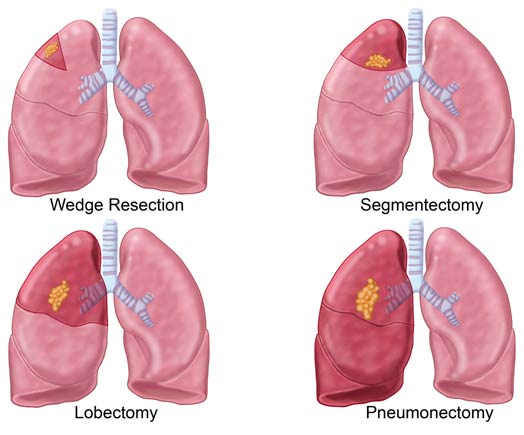Lung cancer is the cancer that starts in the windpipe (trachea), the main airway (bronchus) or the lung tissue. It is of several different types and these are divided into two main groups: small cell lung cancer (SCLC) and non-small cell lung cancer (NSCLC).
It is the second most commonly occurring cancer in the world.

Symptoms of lung cancer
The symptoms of lung cancer may include
-
Cough
-
A hoarse voice
-
Difficulty swallowing
-
Shortness of breath
-
Blood in the sputum
-
Pain in the chest or shoulder
-
Loss of appetite and weight
-
Tiredness (fatigue)
Diagnosis of Lung Cancer
Diagnosis starts with general physical examination of the patient followed by the following diagnostic tests:
-
Spirometry
-
Sputum test
-
Chest X-ray
-
CT scan
-
Bronchoscopy
-
Endobronchial ultrasound
-
Lung biopsy
-
Neck lymph node biopsy
Laparoscopic surgery for Lung Cancer
Laparoscopy is now used to remove nodules and tumors of the lung cancer. In cases of confirmed cancer, the surgeon performs one of the following procedures using Video Assisted Thoracic Surgery (VATS) or robot-assisted techniques:
-
Wedge resection: This involves removal of the tumor along with the surrounding tissue.
-
Segmental resection: This involves removal of the tumor along with the surrounding anatomic structures.
-
Lobectomy: This involves removal of the entire lobe of the lung that contains the cancerous tissue.
Advantages of Laparoscopic Surgery for Lung Cancer
-
Faster recovery
-
Only few hours or overnight hospitalization
-
Earlier ambulation
-
Sooner return to work
-
Very less pain during and after the procedure
-
Smaller incisions without any cut on abdominal muscles
-
Negligible risks and complications
-
Less chances of wound infection
-
High success rate
li> -
Better chance of breathing normally
-
Better quality of life
Better immune system response








